Ethics and Governance Report: Northern Star Resources Ltd Case Study
VerifiedAdded on 2022/08/14
|11
|2963
|20
Report
AI Summary
This report provides a detailed analysis of the ethics and governance practices of Northern Star Resources Ltd. It begins with an introduction and summary of the company, outlining its operations and key strategic objectives. The report then delves into corporate governance, examining the composition of the board of directors, the chairman and CEO's report, and the remuneration report. It also identifies the company's immediate priorities and plans to achieve them. Furthermore, the report explores board orientation, analyzing it through various theoretical lenses, including agency theory, stewardship theory, and resource dependency theory. Finally, the report interprets Northern Star through the lens of legitimacy theory, discussing how the company operates within societal norms and expectations and the importance of disclosure in maintaining legitimacy. The report concludes by providing a comprehensive overview of the ethical and governance aspects of Northern Star Resources, offering valuable insights into its corporate practices.

Running head: ETHICS AND GOVERNANCE
Ethics and Governance
Name of the Student
Name of the University
Author’s Note
Ethics and Governance
Name of the Student
Name of the University
Author’s Note
Paraphrase This Document
Need a fresh take? Get an instant paraphrase of this document with our AI Paraphraser
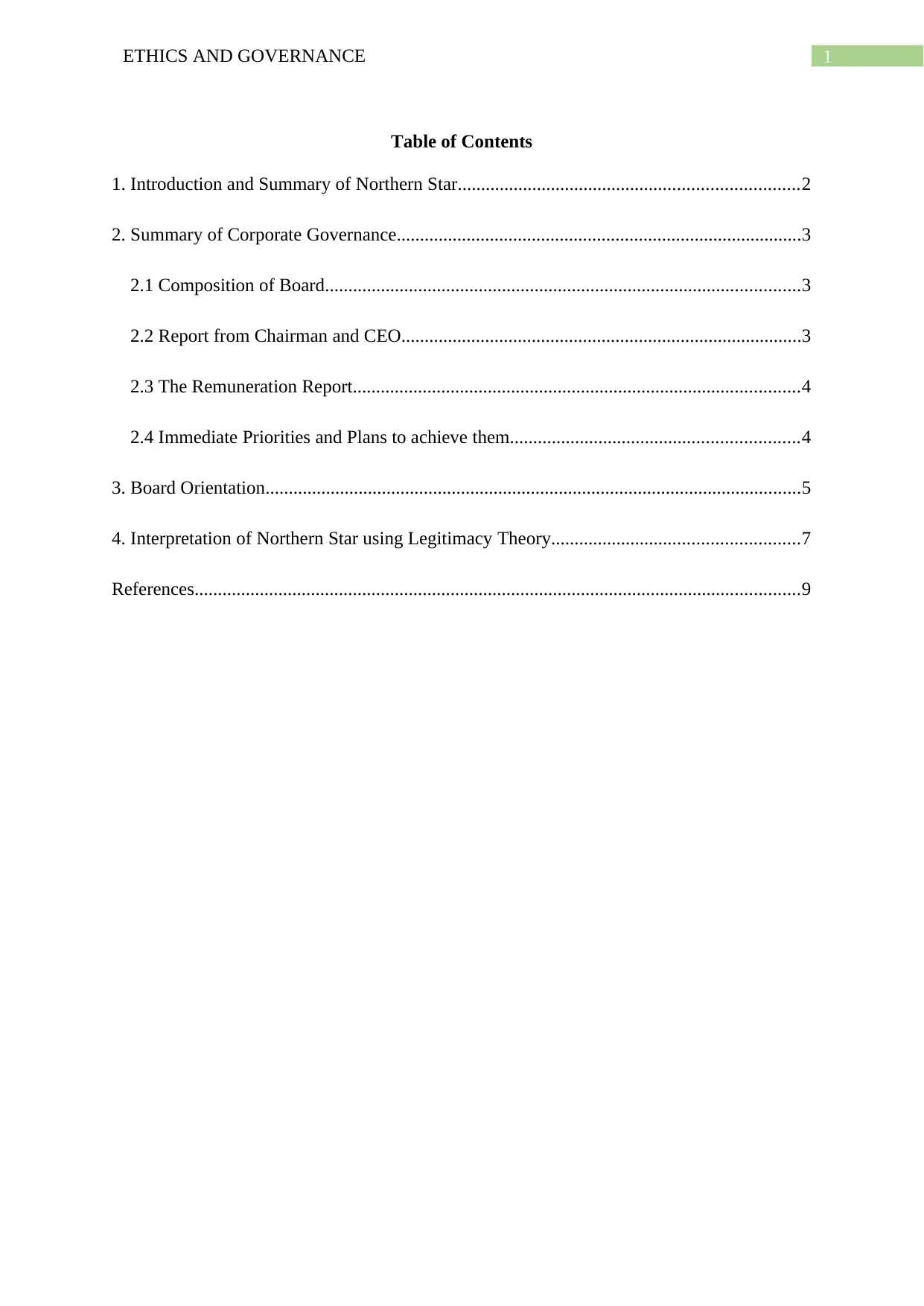
1ETHICS AND GOVERNANCE
Table of Contents
1. Introduction and Summary of Northern Star.........................................................................2
2. Summary of Corporate Governance.......................................................................................3
2.1 Composition of Board......................................................................................................3
2.2 Report from Chairman and CEO......................................................................................3
2.3 The Remuneration Report................................................................................................4
2.4 Immediate Priorities and Plans to achieve them..............................................................4
3. Board Orientation...................................................................................................................5
4. Interpretation of Northern Star using Legitimacy Theory.....................................................7
References..................................................................................................................................9
Table of Contents
1. Introduction and Summary of Northern Star.........................................................................2
2. Summary of Corporate Governance.......................................................................................3
2.1 Composition of Board......................................................................................................3
2.2 Report from Chairman and CEO......................................................................................3
2.3 The Remuneration Report................................................................................................4
2.4 Immediate Priorities and Plans to achieve them..............................................................4
3. Board Orientation...................................................................................................................5
4. Interpretation of Northern Star using Legitimacy Theory.....................................................7
References..................................................................................................................................9
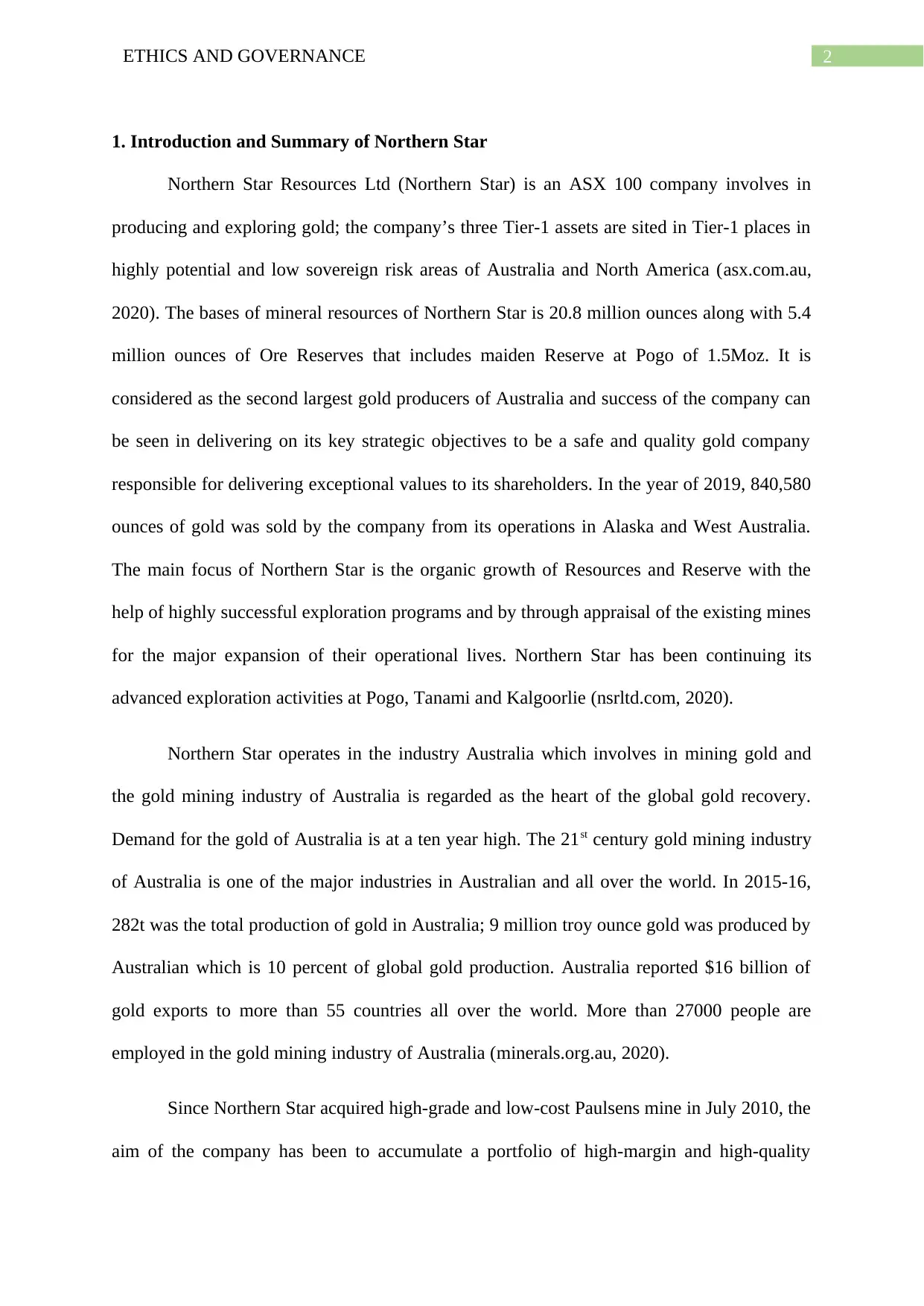
2ETHICS AND GOVERNANCE
1. Introduction and Summary of Northern Star
Northern Star Resources Ltd (Northern Star) is an ASX 100 company involves in
producing and exploring gold; the company’s three Tier-1 assets are sited in Tier-1 places in
highly potential and low sovereign risk areas of Australia and North America (asx.com.au,
2020). The bases of mineral resources of Northern Star is 20.8 million ounces along with 5.4
million ounces of Ore Reserves that includes maiden Reserve at Pogo of 1.5Moz. It is
considered as the second largest gold producers of Australia and success of the company can
be seen in delivering on its key strategic objectives to be a safe and quality gold company
responsible for delivering exceptional values to its shareholders. In the year of 2019, 840,580
ounces of gold was sold by the company from its operations in Alaska and West Australia.
The main focus of Northern Star is the organic growth of Resources and Reserve with the
help of highly successful exploration programs and by through appraisal of the existing mines
for the major expansion of their operational lives. Northern Star has been continuing its
advanced exploration activities at Pogo, Tanami and Kalgoorlie (nsrltd.com, 2020).
Northern Star operates in the industry Australia which involves in mining gold and
the gold mining industry of Australia is regarded as the heart of the global gold recovery.
Demand for the gold of Australia is at a ten year high. The 21st century gold mining industry
of Australia is one of the major industries in Australian and all over the world. In 2015-16,
282t was the total production of gold in Australia; 9 million troy ounce gold was produced by
Australian which is 10 percent of global gold production. Australia reported $16 billion of
gold exports to more than 55 countries all over the world. More than 27000 people are
employed in the gold mining industry of Australia (minerals.org.au, 2020).
Since Northern Star acquired high-grade and low-cost Paulsens mine in July 2010, the
aim of the company has been to accumulate a portfolio of high-margin and high-quality
1. Introduction and Summary of Northern Star
Northern Star Resources Ltd (Northern Star) is an ASX 100 company involves in
producing and exploring gold; the company’s three Tier-1 assets are sited in Tier-1 places in
highly potential and low sovereign risk areas of Australia and North America (asx.com.au,
2020). The bases of mineral resources of Northern Star is 20.8 million ounces along with 5.4
million ounces of Ore Reserves that includes maiden Reserve at Pogo of 1.5Moz. It is
considered as the second largest gold producers of Australia and success of the company can
be seen in delivering on its key strategic objectives to be a safe and quality gold company
responsible for delivering exceptional values to its shareholders. In the year of 2019, 840,580
ounces of gold was sold by the company from its operations in Alaska and West Australia.
The main focus of Northern Star is the organic growth of Resources and Reserve with the
help of highly successful exploration programs and by through appraisal of the existing mines
for the major expansion of their operational lives. Northern Star has been continuing its
advanced exploration activities at Pogo, Tanami and Kalgoorlie (nsrltd.com, 2020).
Northern Star operates in the industry Australia which involves in mining gold and
the gold mining industry of Australia is regarded as the heart of the global gold recovery.
Demand for the gold of Australia is at a ten year high. The 21st century gold mining industry
of Australia is one of the major industries in Australian and all over the world. In 2015-16,
282t was the total production of gold in Australia; 9 million troy ounce gold was produced by
Australian which is 10 percent of global gold production. Australia reported $16 billion of
gold exports to more than 55 countries all over the world. More than 27000 people are
employed in the gold mining industry of Australia (minerals.org.au, 2020).
Since Northern Star acquired high-grade and low-cost Paulsens mine in July 2010, the
aim of the company has been to accumulate a portfolio of high-margin and high-quality
⊘ This is a preview!⊘
Do you want full access?
Subscribe today to unlock all pages.

Trusted by 1+ million students worldwide
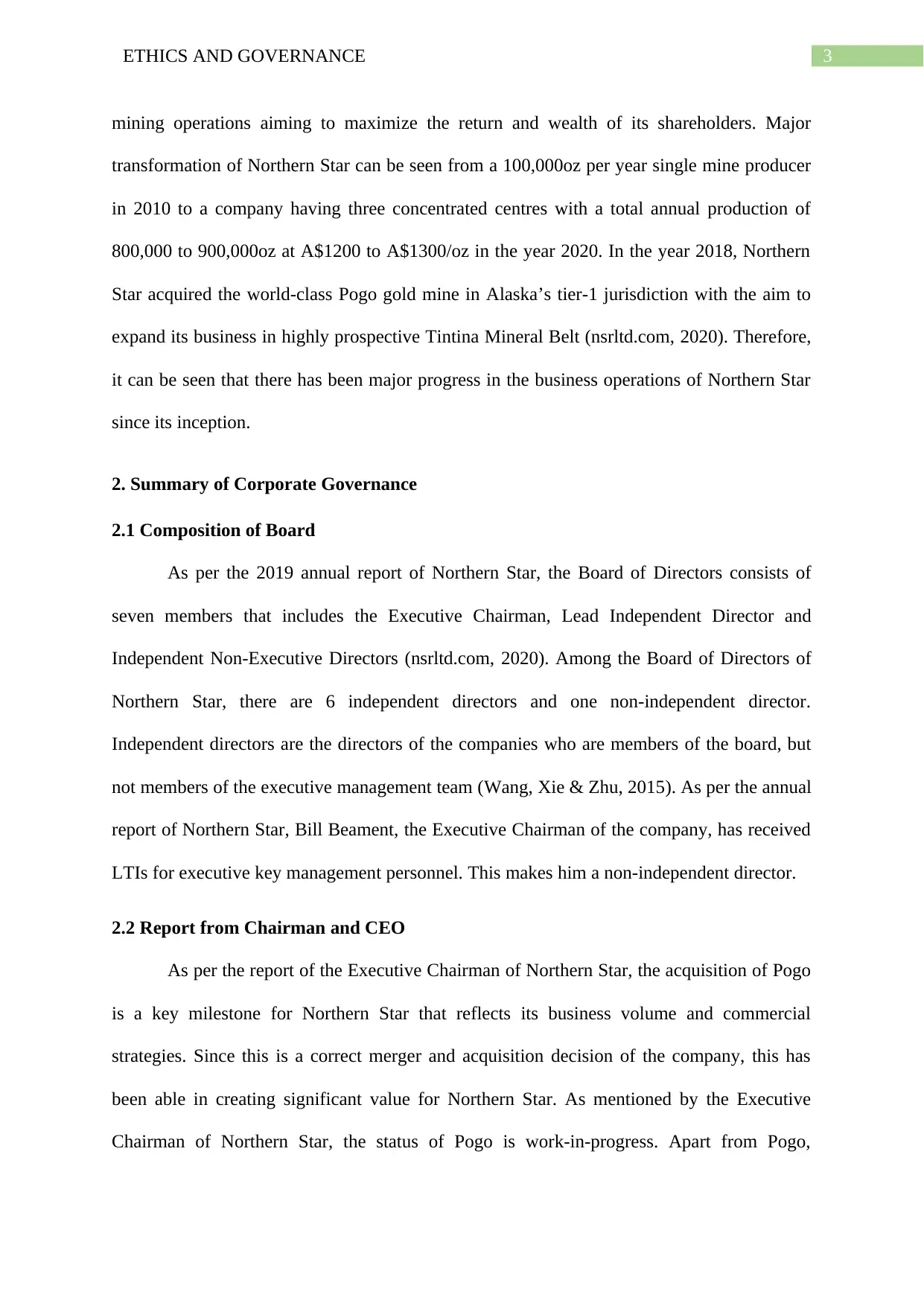
3ETHICS AND GOVERNANCE
mining operations aiming to maximize the return and wealth of its shareholders. Major
transformation of Northern Star can be seen from a 100,000oz per year single mine producer
in 2010 to a company having three concentrated centres with a total annual production of
800,000 to 900,000oz at A$1200 to A$1300/oz in the year 2020. In the year 2018, Northern
Star acquired the world-class Pogo gold mine in Alaska’s tier-1 jurisdiction with the aim to
expand its business in highly prospective Tintina Mineral Belt (nsrltd.com, 2020). Therefore,
it can be seen that there has been major progress in the business operations of Northern Star
since its inception.
2. Summary of Corporate Governance
2.1 Composition of Board
As per the 2019 annual report of Northern Star, the Board of Directors consists of
seven members that includes the Executive Chairman, Lead Independent Director and
Independent Non-Executive Directors (nsrltd.com, 2020). Among the Board of Directors of
Northern Star, there are 6 independent directors and one non-independent director.
Independent directors are the directors of the companies who are members of the board, but
not members of the executive management team (Wang, Xie & Zhu, 2015). As per the annual
report of Northern Star, Bill Beament, the Executive Chairman of the company, has received
LTIs for executive key management personnel. This makes him a non-independent director.
2.2 Report from Chairman and CEO
As per the report of the Executive Chairman of Northern Star, the acquisition of Pogo
is a key milestone for Northern Star that reflects its business volume and commercial
strategies. Since this is a correct merger and acquisition decision of the company, this has
been able in creating significant value for Northern Star. As mentioned by the Executive
Chairman of Northern Star, the status of Pogo is work-in-progress. Apart from Pogo,
mining operations aiming to maximize the return and wealth of its shareholders. Major
transformation of Northern Star can be seen from a 100,000oz per year single mine producer
in 2010 to a company having three concentrated centres with a total annual production of
800,000 to 900,000oz at A$1200 to A$1300/oz in the year 2020. In the year 2018, Northern
Star acquired the world-class Pogo gold mine in Alaska’s tier-1 jurisdiction with the aim to
expand its business in highly prospective Tintina Mineral Belt (nsrltd.com, 2020). Therefore,
it can be seen that there has been major progress in the business operations of Northern Star
since its inception.
2. Summary of Corporate Governance
2.1 Composition of Board
As per the 2019 annual report of Northern Star, the Board of Directors consists of
seven members that includes the Executive Chairman, Lead Independent Director and
Independent Non-Executive Directors (nsrltd.com, 2020). Among the Board of Directors of
Northern Star, there are 6 independent directors and one non-independent director.
Independent directors are the directors of the companies who are members of the board, but
not members of the executive management team (Wang, Xie & Zhu, 2015). As per the annual
report of Northern Star, Bill Beament, the Executive Chairman of the company, has received
LTIs for executive key management personnel. This makes him a non-independent director.
2.2 Report from Chairman and CEO
As per the report of the Executive Chairman of Northern Star, the acquisition of Pogo
is a key milestone for Northern Star that reflects its business volume and commercial
strategies. Since this is a correct merger and acquisition decision of the company, this has
been able in creating significant value for Northern Star. As mentioned by the Executive
Chairman of Northern Star, the status of Pogo is work-in-progress. Apart from Pogo,
Paraphrase This Document
Need a fresh take? Get an instant paraphrase of this document with our AI Paraphraser
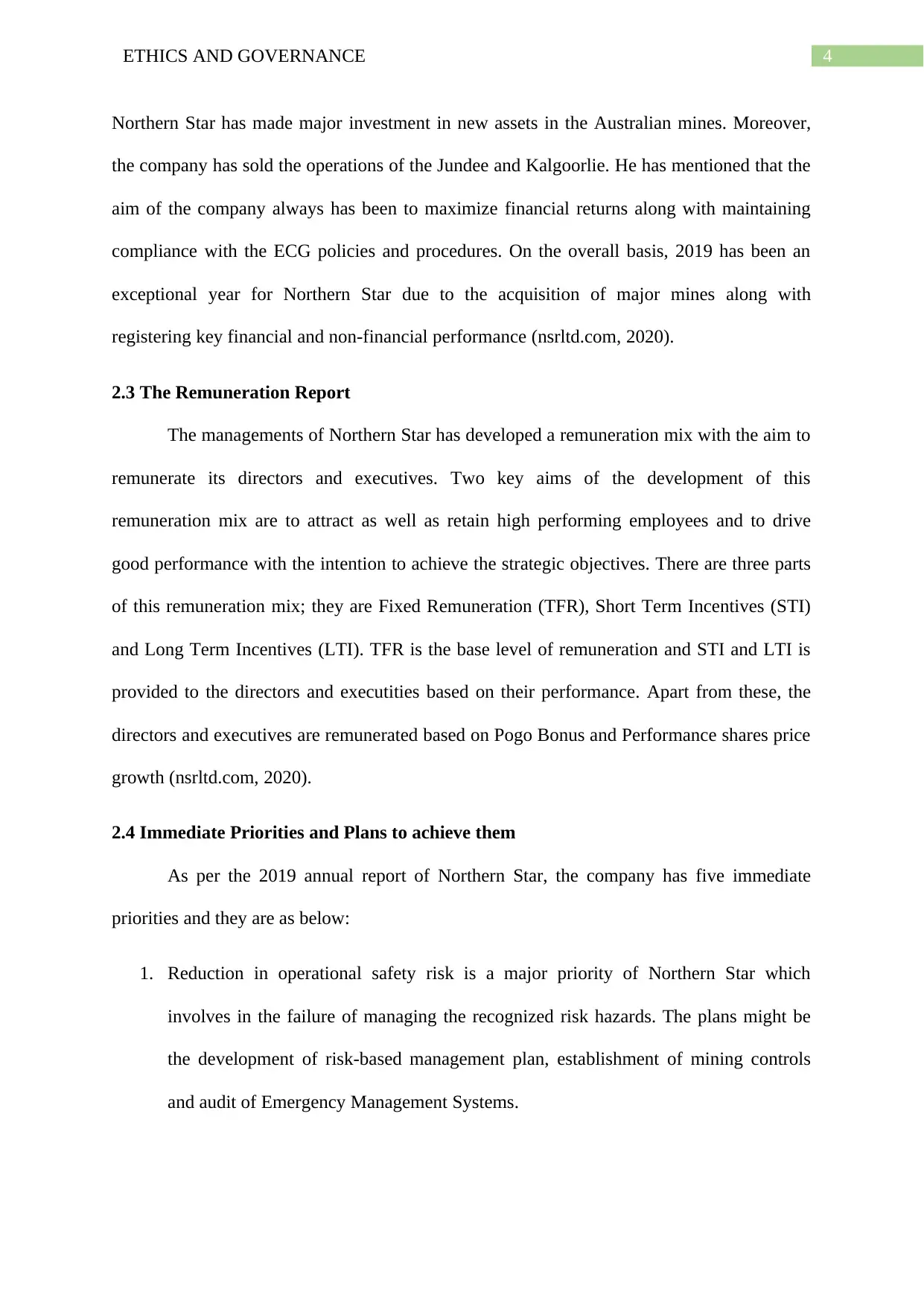
4ETHICS AND GOVERNANCE
Northern Star has made major investment in new assets in the Australian mines. Moreover,
the company has sold the operations of the Jundee and Kalgoorlie. He has mentioned that the
aim of the company always has been to maximize financial returns along with maintaining
compliance with the ECG policies and procedures. On the overall basis, 2019 has been an
exceptional year for Northern Star due to the acquisition of major mines along with
registering key financial and non-financial performance (nsrltd.com, 2020).
2.3 The Remuneration Report
The managements of Northern Star has developed a remuneration mix with the aim to
remunerate its directors and executives. Two key aims of the development of this
remuneration mix are to attract as well as retain high performing employees and to drive
good performance with the intention to achieve the strategic objectives. There are three parts
of this remuneration mix; they are Fixed Remuneration (TFR), Short Term Incentives (STI)
and Long Term Incentives (LTI). TFR is the base level of remuneration and STI and LTI is
provided to the directors and executities based on their performance. Apart from these, the
directors and executives are remunerated based on Pogo Bonus and Performance shares price
growth (nsrltd.com, 2020).
2.4 Immediate Priorities and Plans to achieve them
As per the 2019 annual report of Northern Star, the company has five immediate
priorities and they are as below:
1. Reduction in operational safety risk is a major priority of Northern Star which
involves in the failure of managing the recognized risk hazards. The plans might be
the development of risk-based management plan, establishment of mining controls
and audit of Emergency Management Systems.
Northern Star has made major investment in new assets in the Australian mines. Moreover,
the company has sold the operations of the Jundee and Kalgoorlie. He has mentioned that the
aim of the company always has been to maximize financial returns along with maintaining
compliance with the ECG policies and procedures. On the overall basis, 2019 has been an
exceptional year for Northern Star due to the acquisition of major mines along with
registering key financial and non-financial performance (nsrltd.com, 2020).
2.3 The Remuneration Report
The managements of Northern Star has developed a remuneration mix with the aim to
remunerate its directors and executives. Two key aims of the development of this
remuneration mix are to attract as well as retain high performing employees and to drive
good performance with the intention to achieve the strategic objectives. There are three parts
of this remuneration mix; they are Fixed Remuneration (TFR), Short Term Incentives (STI)
and Long Term Incentives (LTI). TFR is the base level of remuneration and STI and LTI is
provided to the directors and executities based on their performance. Apart from these, the
directors and executives are remunerated based on Pogo Bonus and Performance shares price
growth (nsrltd.com, 2020).
2.4 Immediate Priorities and Plans to achieve them
As per the 2019 annual report of Northern Star, the company has five immediate
priorities and they are as below:
1. Reduction in operational safety risk is a major priority of Northern Star which
involves in the failure of managing the recognized risk hazards. The plans might be
the development of risk-based management plan, establishment of mining controls
and audit of Emergency Management Systems.
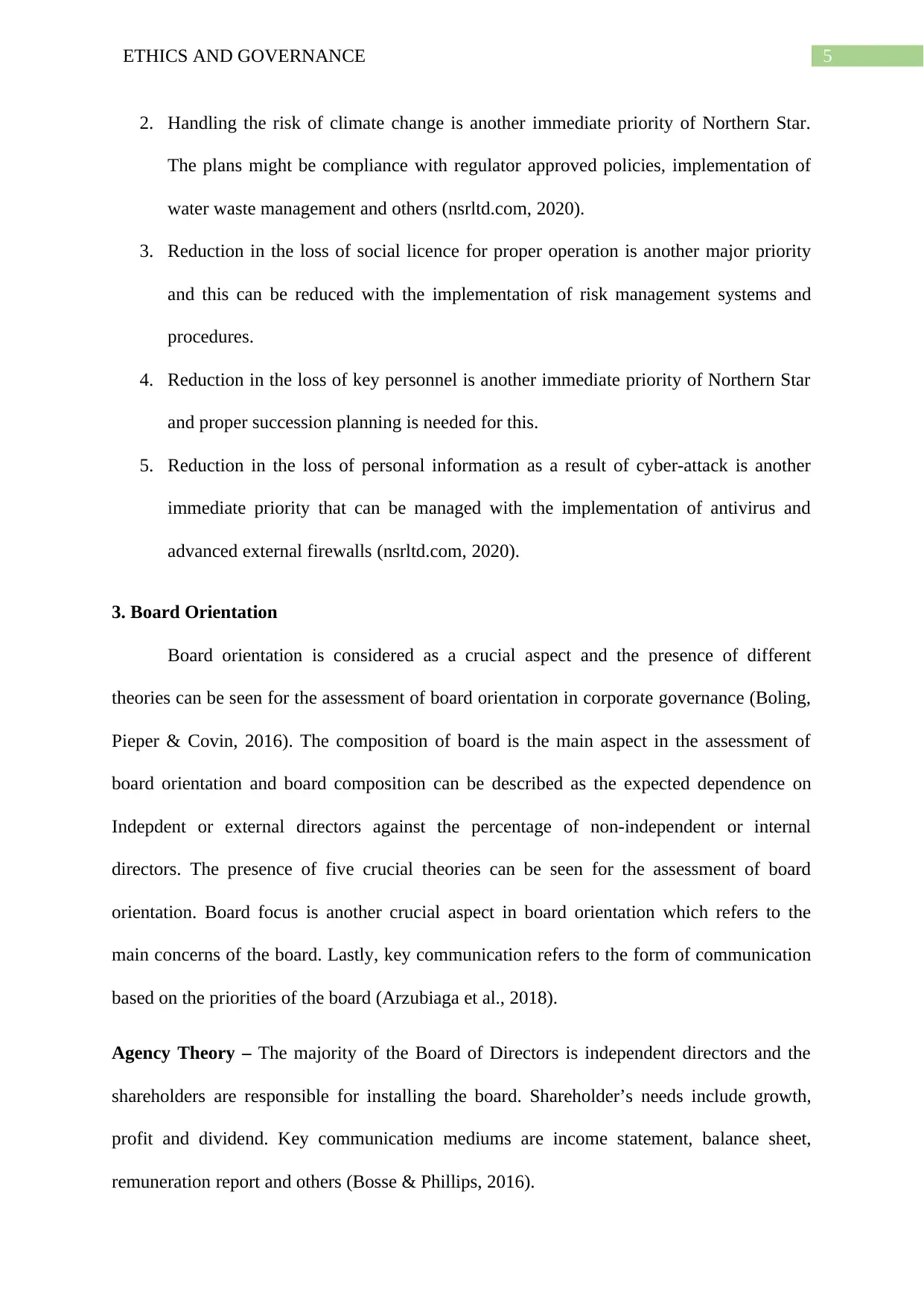
5ETHICS AND GOVERNANCE
2. Handling the risk of climate change is another immediate priority of Northern Star.
The plans might be compliance with regulator approved policies, implementation of
water waste management and others (nsrltd.com, 2020).
3. Reduction in the loss of social licence for proper operation is another major priority
and this can be reduced with the implementation of risk management systems and
procedures.
4. Reduction in the loss of key personnel is another immediate priority of Northern Star
and proper succession planning is needed for this.
5. Reduction in the loss of personal information as a result of cyber-attack is another
immediate priority that can be managed with the implementation of antivirus and
advanced external firewalls (nsrltd.com, 2020).
3. Board Orientation
Board orientation is considered as a crucial aspect and the presence of different
theories can be seen for the assessment of board orientation in corporate governance (Boling,
Pieper & Covin, 2016). The composition of board is the main aspect in the assessment of
board orientation and board composition can be described as the expected dependence on
Indepdent or external directors against the percentage of non-independent or internal
directors. The presence of five crucial theories can be seen for the assessment of board
orientation. Board focus is another crucial aspect in board orientation which refers to the
main concerns of the board. Lastly, key communication refers to the form of communication
based on the priorities of the board (Arzubiaga et al., 2018).
Agency Theory – The majority of the Board of Directors is independent directors and the
shareholders are responsible for installing the board. Shareholder’s needs include growth,
profit and dividend. Key communication mediums are income statement, balance sheet,
remuneration report and others (Bosse & Phillips, 2016).
2. Handling the risk of climate change is another immediate priority of Northern Star.
The plans might be compliance with regulator approved policies, implementation of
water waste management and others (nsrltd.com, 2020).
3. Reduction in the loss of social licence for proper operation is another major priority
and this can be reduced with the implementation of risk management systems and
procedures.
4. Reduction in the loss of key personnel is another immediate priority of Northern Star
and proper succession planning is needed for this.
5. Reduction in the loss of personal information as a result of cyber-attack is another
immediate priority that can be managed with the implementation of antivirus and
advanced external firewalls (nsrltd.com, 2020).
3. Board Orientation
Board orientation is considered as a crucial aspect and the presence of different
theories can be seen for the assessment of board orientation in corporate governance (Boling,
Pieper & Covin, 2016). The composition of board is the main aspect in the assessment of
board orientation and board composition can be described as the expected dependence on
Indepdent or external directors against the percentage of non-independent or internal
directors. The presence of five crucial theories can be seen for the assessment of board
orientation. Board focus is another crucial aspect in board orientation which refers to the
main concerns of the board. Lastly, key communication refers to the form of communication
based on the priorities of the board (Arzubiaga et al., 2018).
Agency Theory – The majority of the Board of Directors is independent directors and the
shareholders are responsible for installing the board. Shareholder’s needs include growth,
profit and dividend. Key communication mediums are income statement, balance sheet,
remuneration report and others (Bosse & Phillips, 2016).
⊘ This is a preview!⊘
Do you want full access?
Subscribe today to unlock all pages.

Trusted by 1+ million students worldwide
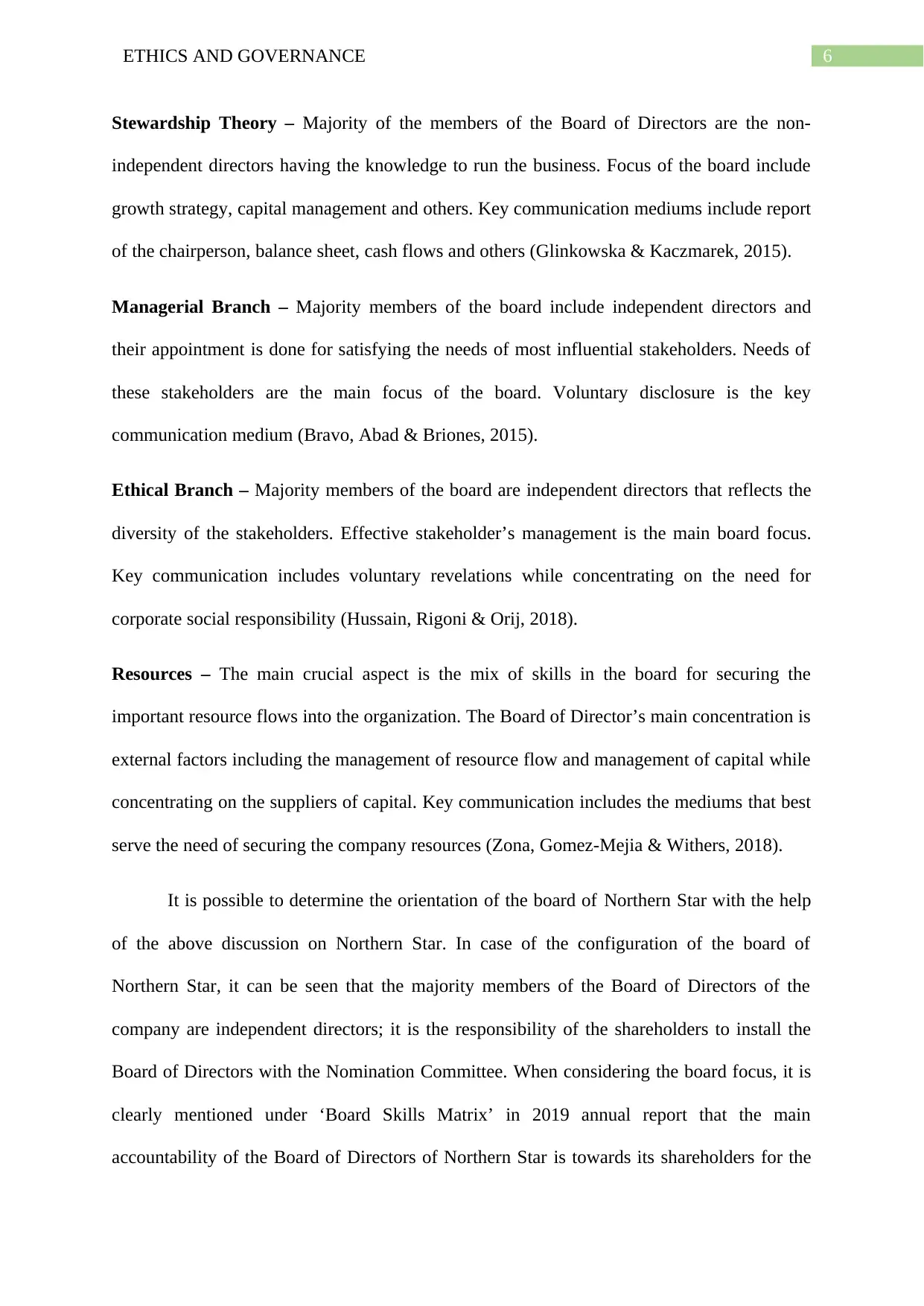
6ETHICS AND GOVERNANCE
Stewardship Theory – Majority of the members of the Board of Directors are the non-
independent directors having the knowledge to run the business. Focus of the board include
growth strategy, capital management and others. Key communication mediums include report
of the chairperson, balance sheet, cash flows and others (Glinkowska & Kaczmarek, 2015).
Managerial Branch – Majority members of the board include independent directors and
their appointment is done for satisfying the needs of most influential stakeholders. Needs of
these stakeholders are the main focus of the board. Voluntary disclosure is the key
communication medium (Bravo, Abad & Briones, 2015).
Ethical Branch – Majority members of the board are independent directors that reflects the
diversity of the stakeholders. Effective stakeholder’s management is the main board focus.
Key communication includes voluntary revelations while concentrating on the need for
corporate social responsibility (Hussain, Rigoni & Orij, 2018).
Resources – The main crucial aspect is the mix of skills in the board for securing the
important resource flows into the organization. The Board of Director’s main concentration is
external factors including the management of resource flow and management of capital while
concentrating on the suppliers of capital. Key communication includes the mediums that best
serve the need of securing the company resources (Zona, Gomez-Mejia & Withers, 2018).
It is possible to determine the orientation of the board of Northern Star with the help
of the above discussion on Northern Star. In case of the configuration of the board of
Northern Star, it can be seen that the majority members of the Board of Directors of the
company are independent directors; it is the responsibility of the shareholders to install the
Board of Directors with the Nomination Committee. When considering the board focus, it is
clearly mentioned under ‘Board Skills Matrix’ in 2019 annual report that the main
accountability of the Board of Directors of Northern Star is towards its shareholders for the
Stewardship Theory – Majority of the members of the Board of Directors are the non-
independent directors having the knowledge to run the business. Focus of the board include
growth strategy, capital management and others. Key communication mediums include report
of the chairperson, balance sheet, cash flows and others (Glinkowska & Kaczmarek, 2015).
Managerial Branch – Majority members of the board include independent directors and
their appointment is done for satisfying the needs of most influential stakeholders. Needs of
these stakeholders are the main focus of the board. Voluntary disclosure is the key
communication medium (Bravo, Abad & Briones, 2015).
Ethical Branch – Majority members of the board are independent directors that reflects the
diversity of the stakeholders. Effective stakeholder’s management is the main board focus.
Key communication includes voluntary revelations while concentrating on the need for
corporate social responsibility (Hussain, Rigoni & Orij, 2018).
Resources – The main crucial aspect is the mix of skills in the board for securing the
important resource flows into the organization. The Board of Director’s main concentration is
external factors including the management of resource flow and management of capital while
concentrating on the suppliers of capital. Key communication includes the mediums that best
serve the need of securing the company resources (Zona, Gomez-Mejia & Withers, 2018).
It is possible to determine the orientation of the board of Northern Star with the help
of the above discussion on Northern Star. In case of the configuration of the board of
Northern Star, it can be seen that the majority members of the Board of Directors of the
company are independent directors; it is the responsibility of the shareholders to install the
Board of Directors with the Nomination Committee. When considering the board focus, it is
clearly mentioned under ‘Board Skills Matrix’ in 2019 annual report that the main
accountability of the Board of Directors of Northern Star is towards its shareholders for the
Paraphrase This Document
Need a fresh take? Get an instant paraphrase of this document with our AI Paraphraser
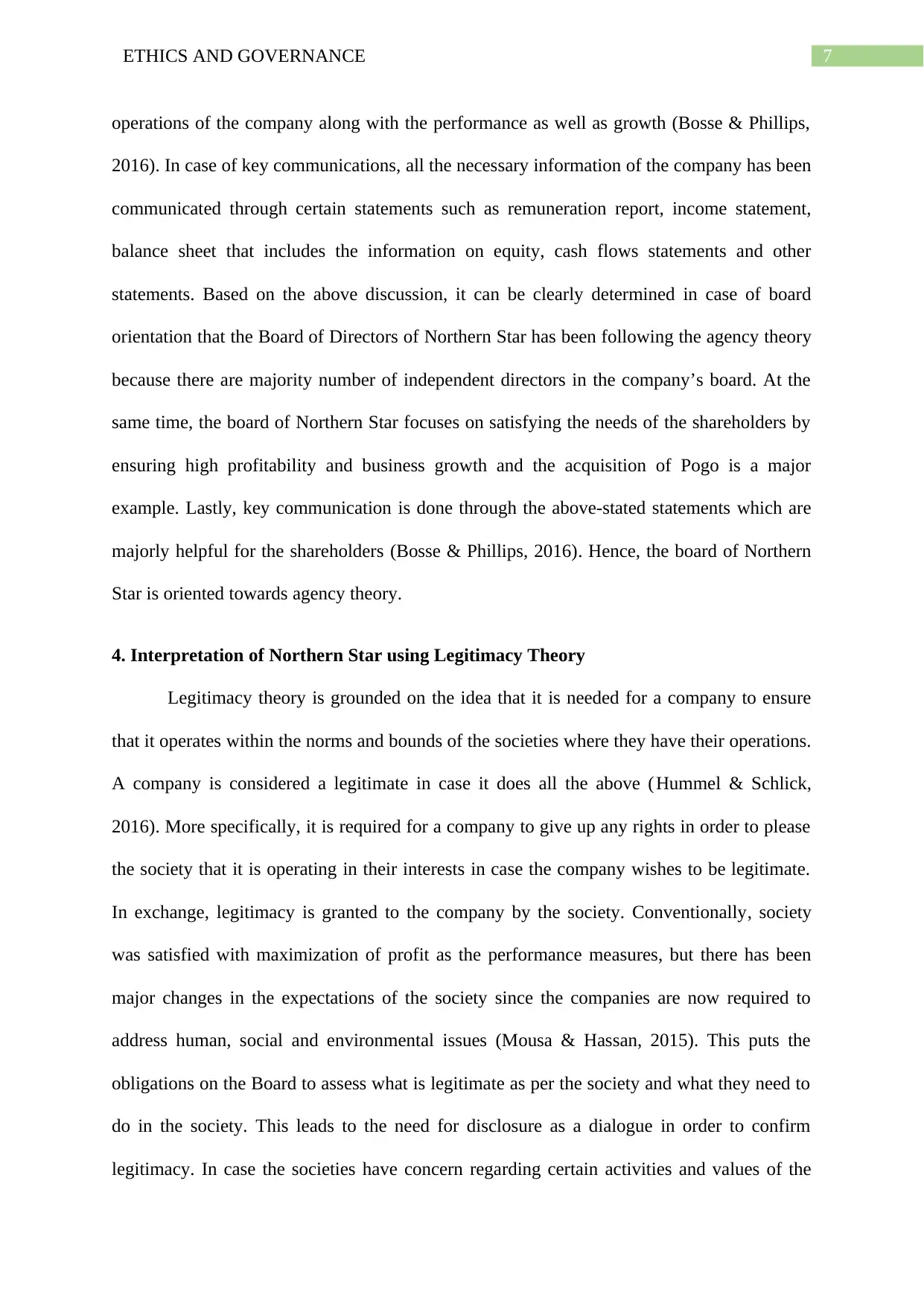
7ETHICS AND GOVERNANCE
operations of the company along with the performance as well as growth (Bosse & Phillips,
2016). In case of key communications, all the necessary information of the company has been
communicated through certain statements such as remuneration report, income statement,
balance sheet that includes the information on equity, cash flows statements and other
statements. Based on the above discussion, it can be clearly determined in case of board
orientation that the Board of Directors of Northern Star has been following the agency theory
because there are majority number of independent directors in the company’s board. At the
same time, the board of Northern Star focuses on satisfying the needs of the shareholders by
ensuring high profitability and business growth and the acquisition of Pogo is a major
example. Lastly, key communication is done through the above-stated statements which are
majorly helpful for the shareholders (Bosse & Phillips, 2016). Hence, the board of Northern
Star is oriented towards agency theory.
4. Interpretation of Northern Star using Legitimacy Theory
Legitimacy theory is grounded on the idea that it is needed for a company to ensure
that it operates within the norms and bounds of the societies where they have their operations.
A company is considered a legitimate in case it does all the above (Hummel & Schlick,
2016). More specifically, it is required for a company to give up any rights in order to please
the society that it is operating in their interests in case the company wishes to be legitimate.
In exchange, legitimacy is granted to the company by the society. Conventionally, society
was satisfied with maximization of profit as the performance measures, but there has been
major changes in the expectations of the society since the companies are now required to
address human, social and environmental issues (Mousa & Hassan, 2015). This puts the
obligations on the Board to assess what is legitimate as per the society and what they need to
do in the society. This leads to the need for disclosure as a dialogue in order to confirm
legitimacy. In case the societies have concern regarding certain activities and values of the
operations of the company along with the performance as well as growth (Bosse & Phillips,
2016). In case of key communications, all the necessary information of the company has been
communicated through certain statements such as remuneration report, income statement,
balance sheet that includes the information on equity, cash flows statements and other
statements. Based on the above discussion, it can be clearly determined in case of board
orientation that the Board of Directors of Northern Star has been following the agency theory
because there are majority number of independent directors in the company’s board. At the
same time, the board of Northern Star focuses on satisfying the needs of the shareholders by
ensuring high profitability and business growth and the acquisition of Pogo is a major
example. Lastly, key communication is done through the above-stated statements which are
majorly helpful for the shareholders (Bosse & Phillips, 2016). Hence, the board of Northern
Star is oriented towards agency theory.
4. Interpretation of Northern Star using Legitimacy Theory
Legitimacy theory is grounded on the idea that it is needed for a company to ensure
that it operates within the norms and bounds of the societies where they have their operations.
A company is considered a legitimate in case it does all the above (Hummel & Schlick,
2016). More specifically, it is required for a company to give up any rights in order to please
the society that it is operating in their interests in case the company wishes to be legitimate.
In exchange, legitimacy is granted to the company by the society. Conventionally, society
was satisfied with maximization of profit as the performance measures, but there has been
major changes in the expectations of the society since the companies are now required to
address human, social and environmental issues (Mousa & Hassan, 2015). This puts the
obligations on the Board to assess what is legitimate as per the society and what they need to
do in the society. This leads to the need for disclosure as a dialogue in order to confirm
legitimacy. In case the societies have concern regarding certain activities and values of the
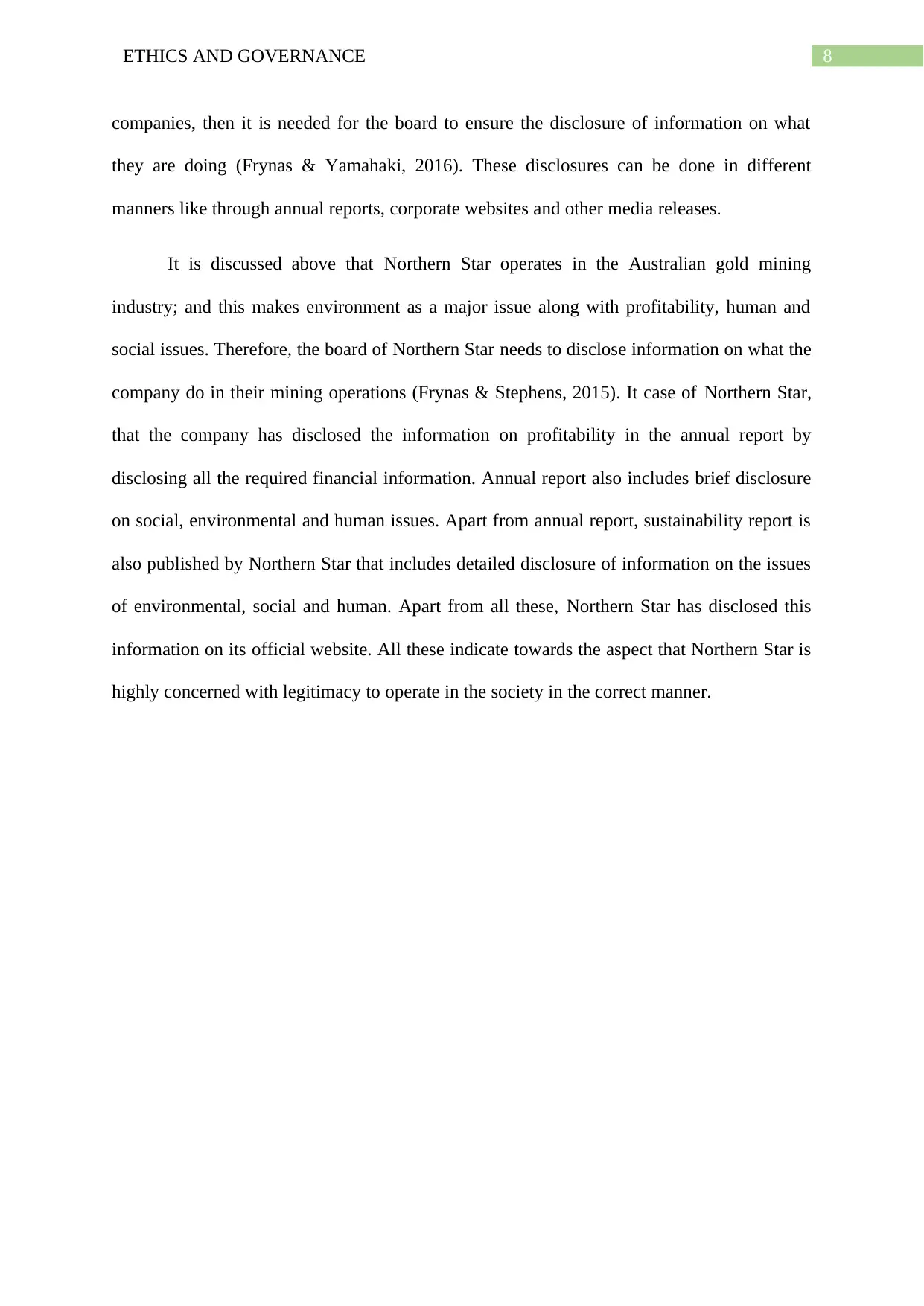
8ETHICS AND GOVERNANCE
companies, then it is needed for the board to ensure the disclosure of information on what
they are doing (Frynas & Yamahaki, 2016). These disclosures can be done in different
manners like through annual reports, corporate websites and other media releases.
It is discussed above that Northern Star operates in the Australian gold mining
industry; and this makes environment as a major issue along with profitability, human and
social issues. Therefore, the board of Northern Star needs to disclose information on what the
company do in their mining operations (Frynas & Stephens, 2015). It case of Northern Star,
that the company has disclosed the information on profitability in the annual report by
disclosing all the required financial information. Annual report also includes brief disclosure
on social, environmental and human issues. Apart from annual report, sustainability report is
also published by Northern Star that includes detailed disclosure of information on the issues
of environmental, social and human. Apart from all these, Northern Star has disclosed this
information on its official website. All these indicate towards the aspect that Northern Star is
highly concerned with legitimacy to operate in the society in the correct manner.
companies, then it is needed for the board to ensure the disclosure of information on what
they are doing (Frynas & Yamahaki, 2016). These disclosures can be done in different
manners like through annual reports, corporate websites and other media releases.
It is discussed above that Northern Star operates in the Australian gold mining
industry; and this makes environment as a major issue along with profitability, human and
social issues. Therefore, the board of Northern Star needs to disclose information on what the
company do in their mining operations (Frynas & Stephens, 2015). It case of Northern Star,
that the company has disclosed the information on profitability in the annual report by
disclosing all the required financial information. Annual report also includes brief disclosure
on social, environmental and human issues. Apart from annual report, sustainability report is
also published by Northern Star that includes detailed disclosure of information on the issues
of environmental, social and human. Apart from all these, Northern Star has disclosed this
information on its official website. All these indicate towards the aspect that Northern Star is
highly concerned with legitimacy to operate in the society in the correct manner.
⊘ This is a preview!⊘
Do you want full access?
Subscribe today to unlock all pages.

Trusted by 1+ million students worldwide
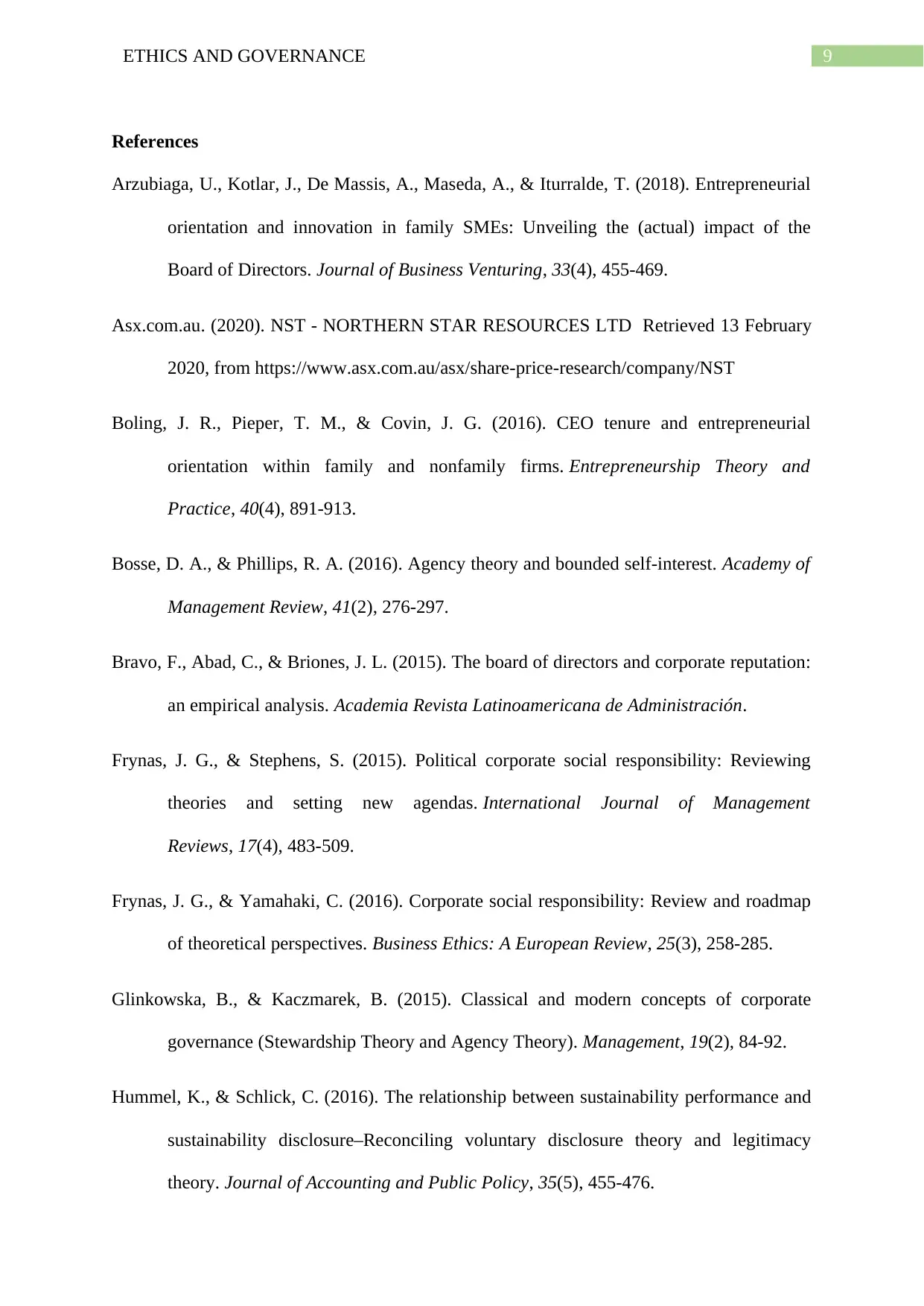
9ETHICS AND GOVERNANCE
References
Arzubiaga, U., Kotlar, J., De Massis, A., Maseda, A., & Iturralde, T. (2018). Entrepreneurial
orientation and innovation in family SMEs: Unveiling the (actual) impact of the
Board of Directors. Journal of Business Venturing, 33(4), 455-469.
Asx.com.au. (2020). NST - NORTHERN STAR RESOURCES LTD Retrieved 13 February
2020, from https://www.asx.com.au/asx/share-price-research/company/NST
Boling, J. R., Pieper, T. M., & Covin, J. G. (2016). CEO tenure and entrepreneurial
orientation within family and nonfamily firms. Entrepreneurship Theory and
Practice, 40(4), 891-913.
Bosse, D. A., & Phillips, R. A. (2016). Agency theory and bounded self-interest. Academy of
Management Review, 41(2), 276-297.
Bravo, F., Abad, C., & Briones, J. L. (2015). The board of directors and corporate reputation:
an empirical analysis. Academia Revista Latinoamericana de Administración.
Frynas, J. G., & Stephens, S. (2015). Political corporate social responsibility: Reviewing
theories and setting new agendas. International Journal of Management
Reviews, 17(4), 483-509.
Frynas, J. G., & Yamahaki, C. (2016). Corporate social responsibility: Review and roadmap
of theoretical perspectives. Business Ethics: A European Review, 25(3), 258-285.
Glinkowska, B., & Kaczmarek, B. (2015). Classical and modern concepts of corporate
governance (Stewardship Theory and Agency Theory). Management, 19(2), 84-92.
Hummel, K., & Schlick, C. (2016). The relationship between sustainability performance and
sustainability disclosure–Reconciling voluntary disclosure theory and legitimacy
theory. Journal of Accounting and Public Policy, 35(5), 455-476.
References
Arzubiaga, U., Kotlar, J., De Massis, A., Maseda, A., & Iturralde, T. (2018). Entrepreneurial
orientation and innovation in family SMEs: Unveiling the (actual) impact of the
Board of Directors. Journal of Business Venturing, 33(4), 455-469.
Asx.com.au. (2020). NST - NORTHERN STAR RESOURCES LTD Retrieved 13 February
2020, from https://www.asx.com.au/asx/share-price-research/company/NST
Boling, J. R., Pieper, T. M., & Covin, J. G. (2016). CEO tenure and entrepreneurial
orientation within family and nonfamily firms. Entrepreneurship Theory and
Practice, 40(4), 891-913.
Bosse, D. A., & Phillips, R. A. (2016). Agency theory and bounded self-interest. Academy of
Management Review, 41(2), 276-297.
Bravo, F., Abad, C., & Briones, J. L. (2015). The board of directors and corporate reputation:
an empirical analysis. Academia Revista Latinoamericana de Administración.
Frynas, J. G., & Stephens, S. (2015). Political corporate social responsibility: Reviewing
theories and setting new agendas. International Journal of Management
Reviews, 17(4), 483-509.
Frynas, J. G., & Yamahaki, C. (2016). Corporate social responsibility: Review and roadmap
of theoretical perspectives. Business Ethics: A European Review, 25(3), 258-285.
Glinkowska, B., & Kaczmarek, B. (2015). Classical and modern concepts of corporate
governance (Stewardship Theory and Agency Theory). Management, 19(2), 84-92.
Hummel, K., & Schlick, C. (2016). The relationship between sustainability performance and
sustainability disclosure–Reconciling voluntary disclosure theory and legitimacy
theory. Journal of Accounting and Public Policy, 35(5), 455-476.
Paraphrase This Document
Need a fresh take? Get an instant paraphrase of this document with our AI Paraphraser
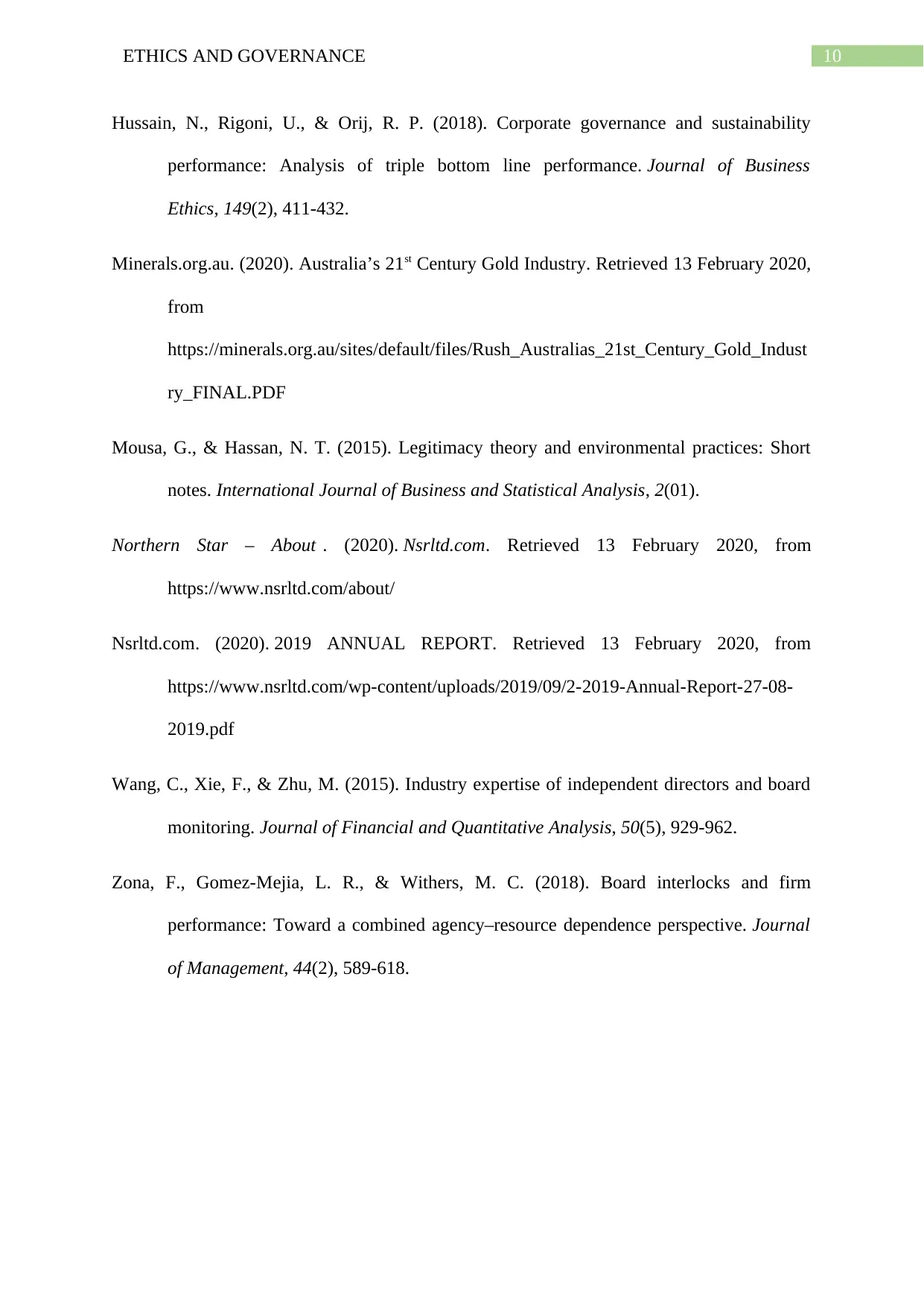
10ETHICS AND GOVERNANCE
Hussain, N., Rigoni, U., & Orij, R. P. (2018). Corporate governance and sustainability
performance: Analysis of triple bottom line performance. Journal of Business
Ethics, 149(2), 411-432.
Minerals.org.au. (2020). Australia’s 21st Century Gold Industry. Retrieved 13 February 2020,
from
https://minerals.org.au/sites/default/files/Rush_Australias_21st_Century_Gold_Indust
ry_FINAL.PDF
Mousa, G., & Hassan, N. T. (2015). Legitimacy theory and environmental practices: Short
notes. International Journal of Business and Statistical Analysis, 2(01).
Northern Star – About . (2020). Nsrltd.com. Retrieved 13 February 2020, from
https://www.nsrltd.com/about/
Nsrltd.com. (2020). 2019 ANNUAL REPORT. Retrieved 13 February 2020, from
https://www.nsrltd.com/wp-content/uploads/2019/09/2-2019-Annual-Report-27-08-
2019.pdf
Wang, C., Xie, F., & Zhu, M. (2015). Industry expertise of independent directors and board
monitoring. Journal of Financial and Quantitative Analysis, 50(5), 929-962.
Zona, F., Gomez-Mejia, L. R., & Withers, M. C. (2018). Board interlocks and firm
performance: Toward a combined agency–resource dependence perspective. Journal
of Management, 44(2), 589-618.
Hussain, N., Rigoni, U., & Orij, R. P. (2018). Corporate governance and sustainability
performance: Analysis of triple bottom line performance. Journal of Business
Ethics, 149(2), 411-432.
Minerals.org.au. (2020). Australia’s 21st Century Gold Industry. Retrieved 13 February 2020,
from
https://minerals.org.au/sites/default/files/Rush_Australias_21st_Century_Gold_Indust
ry_FINAL.PDF
Mousa, G., & Hassan, N. T. (2015). Legitimacy theory and environmental practices: Short
notes. International Journal of Business and Statistical Analysis, 2(01).
Northern Star – About . (2020). Nsrltd.com. Retrieved 13 February 2020, from
https://www.nsrltd.com/about/
Nsrltd.com. (2020). 2019 ANNUAL REPORT. Retrieved 13 February 2020, from
https://www.nsrltd.com/wp-content/uploads/2019/09/2-2019-Annual-Report-27-08-
2019.pdf
Wang, C., Xie, F., & Zhu, M. (2015). Industry expertise of independent directors and board
monitoring. Journal of Financial and Quantitative Analysis, 50(5), 929-962.
Zona, F., Gomez-Mejia, L. R., & Withers, M. C. (2018). Board interlocks and firm
performance: Toward a combined agency–resource dependence perspective. Journal
of Management, 44(2), 589-618.
1 out of 11
Related Documents
Your All-in-One AI-Powered Toolkit for Academic Success.
+13062052269
info@desklib.com
Available 24*7 on WhatsApp / Email
![[object Object]](/_next/static/media/star-bottom.7253800d.svg)
Unlock your academic potential
Copyright © 2020–2025 A2Z Services. All Rights Reserved. Developed and managed by ZUCOL.





